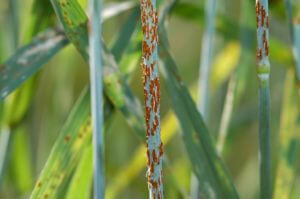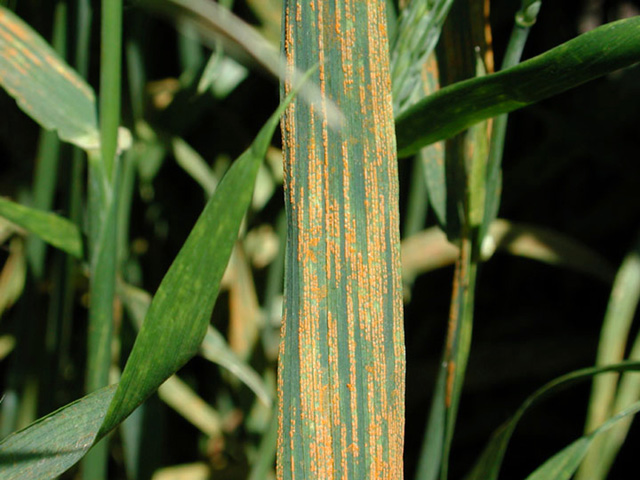Rust threatening wheat crops worldwide could be thwarted with genetics, but anti-GMO fervor remains challenge
 Stem rust, a severe form of wheat rust, can cripple a healthy wheat crop in just a few weeks.
Stem rust, a severe form of wheat rust, can cripple a healthy wheat crop in just a few weeks.
Wheat rust, an infectious fungal disease that affects wheat crops, is known to cause crop losses of between 50 and 80 percent or even total crop failure. Major wheat-growing regions in the world, including the Middle East and North Africa, are afflicted with the disease. A severe outbreak in Ethiopia last November caused farmers to lose on average 50 percent of their wheat crops. Concern is mounting among scientists as the disease is spreading farther to Europe. Last year, Germany reported its first outbreak of a severe form of wheat rust, stem rust, in over fifty years.
“Because wheat is such an important crop, stripe rust is one of those diseases that could have a major, major impact on cereal crop production,” Denis Gaudet of Agriculture and Agri-Food Canada said. “To me, it represents one of the most serious pathogens and potential threats to crop production anywhere in the world.”
New strains of wheat rust have been mutating and evolving constantly to overcome unfavorable weather conditions and the efforts of plant scientists to breed resistance into wheat crops. While chemical fungicide methods exist to control wheat rust infections, scientists are calling for the development of more rust-resistant wheat varieties to combat the disease.
“Production of new seed varieties is critical,” Fazil Dusunceli of the United Nations’ Food and Agriculture Organization has said.
“Polio of agriculture”
Wheat rust is an infectious fungal disease, affecting wheat in almost every country in which it grows. Also known as the “polio of agriculture,” wheat rusts spread by releasing billions of spores in the wind, each of which can start a new infection, and can cause massive crop failures within a few weeks. The fungi associated with the disease infect wheat crops, their hosts, and weaken the crops by removing sugars and nutrients for itself. There are three important types of wheat rust: stripe rust, stem rust and leaf rust.

Stripe rust, also known as yellow rust, shows up in infected wheat crops as yellow stripes.
Stem rust is perhaps the most devastating form of wheat rust, caused by the pathogen Puccinia graminis. Stem rust is a feared disease through history; the Romans sacrificed dogs to Robigus, the Rust God, in attempts to ward off the disease. In the 1940s when North American wheat fields were severely hit with the disease, Norman Borlaug, father of the Green Revolution, crossbred wheat plants to introduce a gene, Sr31, that confers resistance to stem rust. Ten years of effort paid off, and by the 1970s, Borlaug’s rust-resistant varieties of wheat had been widely adopted. It appeared that stem rust had been wiped out. But in 1999, researchers confirmed that stem rust had evolved and returned with a vengeance. The new strain, Ug99, was able to overcome Borlaug’s resistance gene Sr31. By 2007, Ug99 had spread from Uganda, its country of origin, to wheat fields in Kenya, Ethiopia, Yemen and Iran, mutating into more deadly forms along the way.

Image via the Economist, July 2010
Outbreaks of wheat rust can be controlled by monitoring the diseases closely and spraying fungicides. But a better way is to use genetics, by introducing rust resistance into wheat plants and developing rust-resistant varieties of wheat like Borlaug did, according to the FAO.
How genetics can help
Researchers worldwide working to confer wheat rust resistance through breeding or genetic modification have a few key strategies. Kerry Grens reports in a recent article for the Scientist on research efforts to curb Ug99:
Most wheat researchers and breeders agree that to protect plants from Ug99, they must develop wheat varieties with several rust-resistance genes, so that if the fungus mutates to outwit one defense, there are others there to take on the pathogen.Because of the constantly changing nature of Ug99 and Yr27, researchers now see the need to “stack” different types of resistance genes in order to protect wheat plants against the diseases effectively. There are two main types of resistance: major and adult resistance. Major resistance defend the wheat plant against infection by specific strains of rust. Adult resistance, on the other hand, stunts the fungal infection and limits its nutrient intake from the host wheat plants. While adult resistance is only partial, it protects against multiple rust species and lasts for decades before a mutated form of wheat rust overcomes it.
“The goal is to provide cultivars with more than one resistance gene, hopefully three,” said Matt Rouse of the USDA’s Cereal Disease Laboratory in Minnesota. “It might slow down the virulence.”
“Rust never sleeps“
But as Borlaug famously said, “rust never sleeps.” Its constantly changing nature makes it difficult for time-consuming traditional breeding strategies to keep up. In Grens’ report, James Anderson, head of the wheat-breeding program at the University of Minnesota says that it takes about eight to nine years to develop a strain with one gene of interest in a typical wheat-breeding program. If a researcher is looking to stack three or more rust-resistance genes, that would add several more years to the time line.
And climate change adds another dimension to the problem. Plant pathology experts at the International Wheat Stripe Rust Symposium in 2011 said that the rapid spread of rust, especially stripe rust, could be driven by climate change:
Climate change is driving the speed and frequency of today’s new wheat rust problems. It provides the ideal conditions for these new rust races to spread, unchecked, across many countries.In the Middle East, East Africa and South Asia regions where farmers have been planting the same varieties of wheat for 20 – 30 years, the vulnerability of those wheat crops to the new Yr27 and Ug99 wheat rusts is very high. Experts at the Symposium called for diversity in wheat crops and to have various types of rust-resistant varieties of wheat available. But because the appearance of new rust strains is unpredictable, it is unclear how much time crop developers have before the next new form of the disease strikes.
“Our hands are tied”
Genetic engineering could be a faster route for developing new rust-resistant varieties of wheat. In his report, Grens explained that researchers can create a “chunk of chromosome,” also known as a cassette, that contains several resistance genes. Crop developers can then achieve stacked resistance in wheat with a single insertion of the cassette. It would also allow breeders to select more easily for wheat plants with the entire set of resistance genes as they are all carried on the same chromosome.
Genetic engineering would also open up the available genetic resources for rust resistance to include wild relatives of wheat. When breeders cross wheat plants with their wild relatives, the rust resistance genes get transferred together with other unappealing traits such as reduced yields. With genetic engineering, researchers can select the rust resistance genes and insert them into existing high-yielding wheat plants without the undesired traits.
“When you look at what wild crop relatives can contribute to cultivated species, it’s just a phenomenal amount of allelic diversity,” Brian Steffenson, a plant pathologist at the University of Minnesota said.
But many of the research groups working on the problem of wheat rust are academic groups and cannot afford the huge regulatory expenses associated with developing genetically modified crops. Additionally, widespread anti-GMO sentiment needs to be overcome, as unlike most genetically modified corn or soy crops that are used as animal feed, wheat is directly consumed as bread and other wheat products.
“We could do millions of things with transgenics,” Jorge Dubcovsky, a wheat geneticist and breeder at the University of California, Davis, said, “but we have our hands tied.”
Additional Resources:
- “Genetic modification could stop wheat rust epidemic,” Science 2.0
- “Scientists help deliver genetic one-two blow to deadly wheat disease,” Phys.org
No comments:
Post a Comment